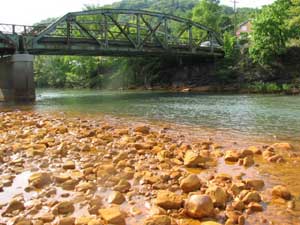 Large-scale coal
mining in The Stonycreek Corridor began in the late 1800s,
a period when there was almost no concern for the
protection of natural resources. Within a few decades, the
Stonycreek River and several of its tributaries were badly
polluted with runoff from boney piles and abandoned-mine
drainage (AMD). Not only was the water acidic - some of it
the strength of vinegar - which itself was harmful to
aquatic life, but it leached metals such as iron, aluminum
and manganese from old underground mine pools. Once
exposed to oxygen, these metals dropped out of suspension
and coated stream bottoms, choking the aquatic insects
upon which life is based within mountain streams. Large-scale coal
mining in The Stonycreek Corridor began in the late 1800s,
a period when there was almost no concern for the
protection of natural resources. Within a few decades, the
Stonycreek River and several of its tributaries were badly
polluted with runoff from boney piles and abandoned-mine
drainage (AMD). Not only was the water acidic - some of it
the strength of vinegar - which itself was harmful to
aquatic life, but it leached metals such as iron, aluminum
and manganese from old underground mine pools. Once
exposed to oxygen, these metals dropped out of suspension
and coated stream bottoms, choking the aquatic insects
upon which life is based within mountain streams.
An AMD evaluation of just a portion of the corridor in the
early 1970s estimated clean-up costs in the hundreds of
millions of dollars, using conventional treatment
technologies of the day. A comprehensive survey in the
early 1990s identified and sampled 270 mine discharges
throughout the river basin. Only 14 percent of the
discharges were meeting all standards for pH, iron and
manganese; only five (1.8%) met secondary drinking water
standards for pH, iron, manganese, aluminum and fluoride.
Comparisons of water samples drawn at Shanksville (near
the headwaters) and Ferndale (only six miles from the
river's mouth) showed:
- pH decreasing from 6.8 to 4.2 (as acidic as tomato
juice).
- Alkalinity completely depleted.
- Iron discharges increasing from 30 to 684 pounds per
day.
- Total-manganese and -sulfates also increased.
However, the Stonycreek River and certain of its
tributaries have recovered dramatically over the past
couple of decades. Contributing factors include:
- Reduction of mining activity within the corridor.
- More-effective mine-regulation by the federal and
state governments.
- Re-mining activity, which has eliminated some AMD
discharges.
- The use of boney materials as fuel for power
cogeneration, resulting in the elimination of some waste
piles.
- And the development of passive treatment systems that
include settling ponds, chambered wetlands utilizing
compost and cattails, and limestone drains
For more information on AMD problems within The
Stonycreek Corridor, read this U.S. Geological Survey Water-Resources
Investigation Report (1996) (1.5mb).
Related Links:
|
|

